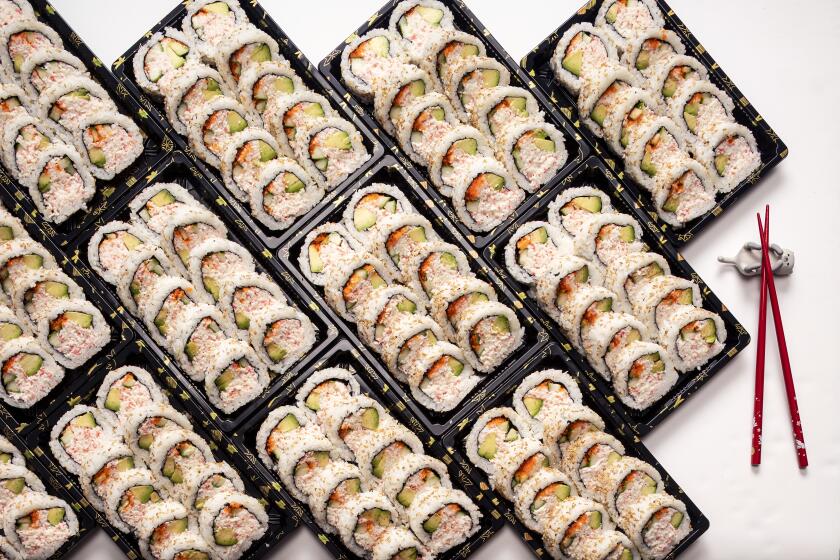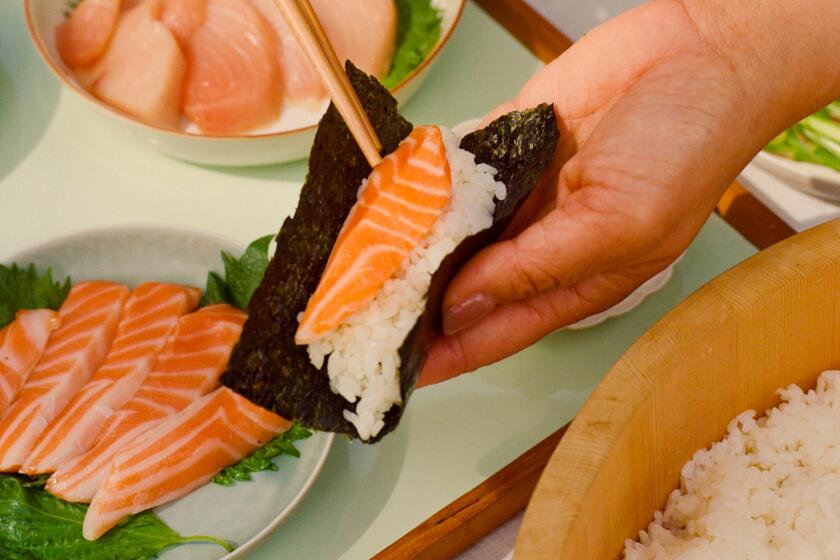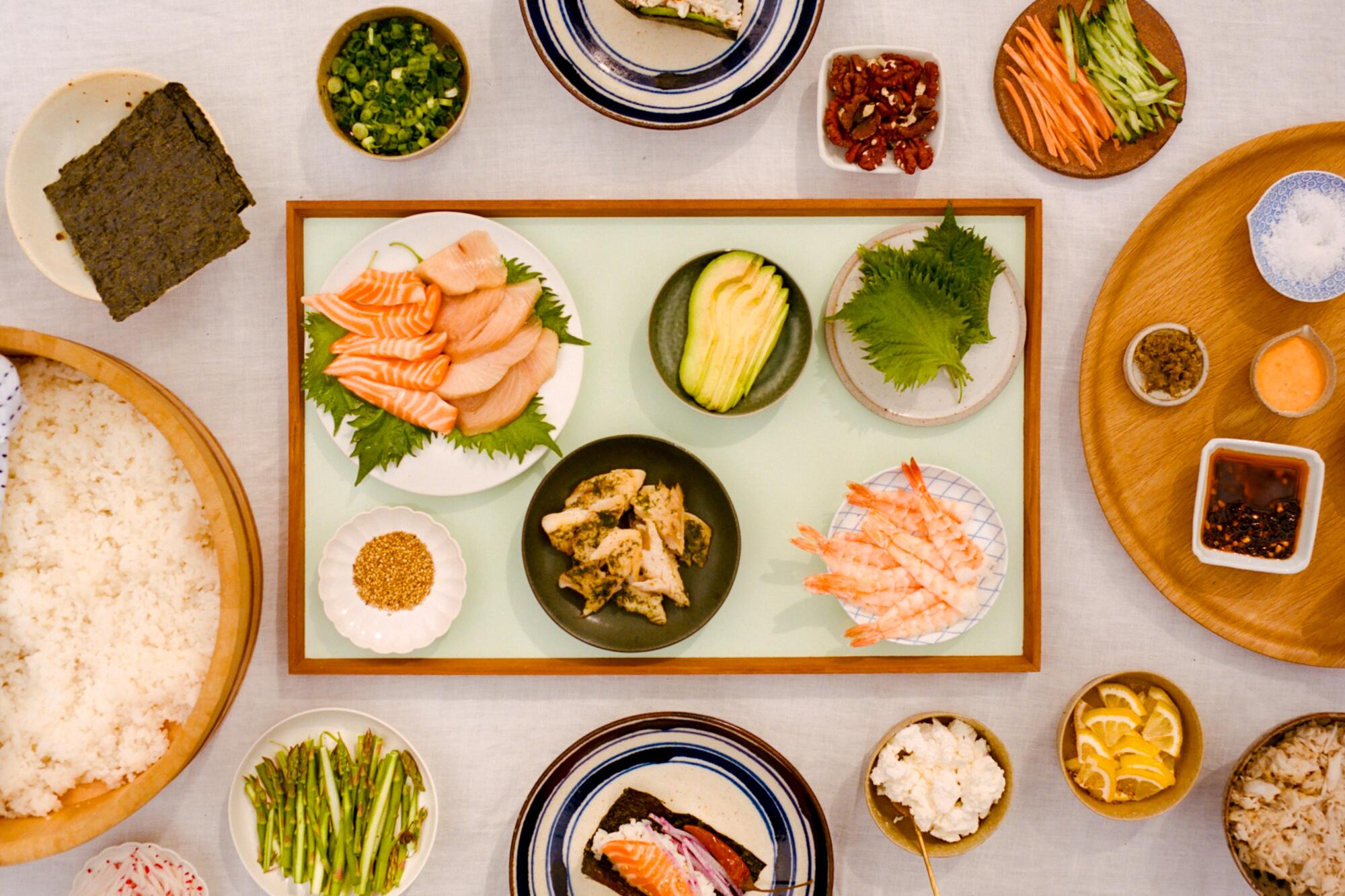
- Share via
All you need for a hand roll party at home is a big bowl of sushi rice, a tall stack of nori (dried sheets of seaweed) and any fillings and condiments you want. Fresh, crunchy vegetables are excellent with sushi rice, and so is leftover carne asada or potato salad — with soy sauce or salsa macha, or sprinkled with nuts, or topped with fruit. Really. I’ve learned that I don’t have to be a traditionalist — or a perfectionist — when it comes to making hand rolls at home. Another plus: The only thing to cook is the rice.
This is your guide to what the best sushi city in America has to offer, from the ultimate California roll to spectacular omakase.
Sushi chefs are revered for the precision with which they cut fish. The level of esteem for sushi rice is reflected in its name shari — it means “bones,” a reference to the sacred enshrined bones of Buddha. And sushi lore says that if shaped properly, all the grains of rice for nigiri will face the same direction.
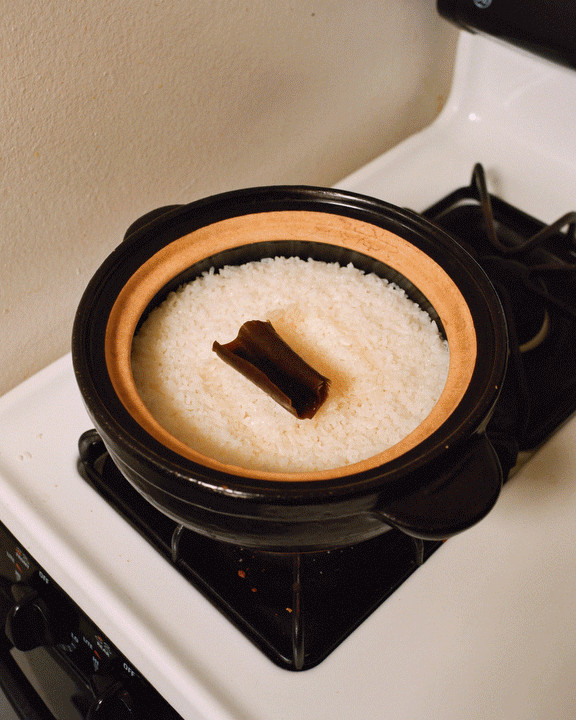
But I grew up eating homemade sushi. My mom made simple rolls — kappa maki, cucumber cut rolls. Or sometimes instead of cucumber, a tuna salad of canned Chicken of the Sea mixed with Kewpie mayonnaise. When she made sushi rice, I’d help fan the rice to cool it down as she mixed in vinegar, sugar and salt, using a shamoji, or wooden spatula. She rolled sheets of nori around rice with a row of cucumbers or tuna salad in the middle to form nearly perfect, compact cylinders, using a small bamboo mat called makisu. “It’s easy!” Mom says.
Hand rolls are even easier. Temaki (te for hand, maki for rolls) are traditionally cones of nori filled with sushi rice and whatever you like. We all know and love L.A.’s iconic blue crab temaki and so many iterations at hand roll bars that lately seem to be proliferating faster than SoulCycle studios in the mid-2010s. It’s even more fun when you make them at home, DIY-style, where everyone creates their own.
The current generation of omakase chefs in Los Angeles are returning to the essence of the cuisine. A trip to Tokyo confirms what’s been driving their pursuit for excellence.
A couple of years ago, I made temaki for a New Year’s Eve dinner with my friend photographer Jeni Afuso. I prepared sushi rice that night, and we gathered ingredients for filling rolls. Other than the rice, nothing was cooked: cucumber, carrots and radishes cut into matchsticks; slivers of asparagus, scallion and myoga, or baby ginger; sliced avocado; kaiware, radish sprouts; a small selection of sashimi. Everything was raw or pickled or tinned, set out family-style in the middle of the table. It was so chill that we made temaki again the next afternoon for New Year’s Day. And then again the following New Year’s Eve. And in between for birthdays and casual dinner parties.
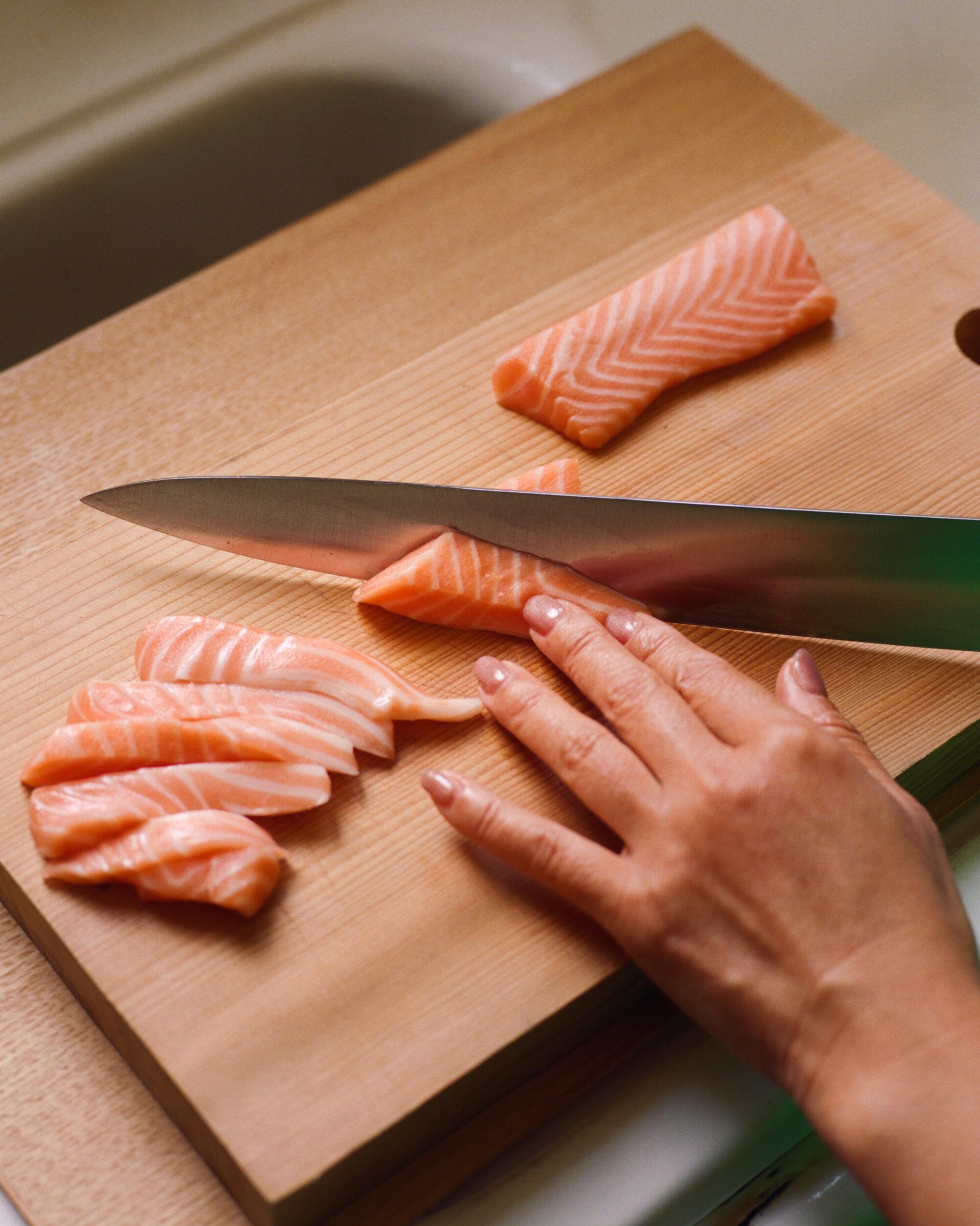
The nori
For hand rolls, nori — shatteringly crisp sheets of it — is as important as sushi rice. The highest-quality Japanese seaweed for nori comes from the Ariake Sea, a huge bay on the southern island of Kyushu. The seaweed is blended, pressed and dried in a process developed by Tokyo paper makers in the 1600s, then graded according to the time of year it was harvested and dozens of other criteria such as color, flavor, hagire (crispiness) and kuchidoke (the texture that makes it melt in your mouth). When you bite into the best nori, it explodes with crackle, flavor and aroma, and then it practically dissolves.
Which is all to say: You should buy the best nori you can afford. It should be so crisp that you can fold the seaweed paper and it will snap cleanly in half. Japanese markets offer increasingly more varieties, and I’ve seen a favorite brand, Mikuniya (from Ariake), at stores such as Nijiya Market.
Nori comes in a standard size, about 8 by 7 inches. Most temaki at sushi bars is made with a half-sheet of nori (to form a cone). Like many home cooks, I use a quarter-sheet for hand rolls. Snap or cut the nori in half once, then in half again for a nearly square quarter-sheet. Top the nori with a small amount of seasoned rice and whatever fillings you want. Then just fold it like a taco, either edge to edge for a rectangle or corner to corner for a triangle.
The best hand roll bars in Los Angeles are part of the fabric of the city’s sushi scene, serving delicious, super-fresh temaki at affordable prices.
The rice
Sushi rice is probably considered the hand roll party centerpiece, and yes, there are nuances when it comes to preparing it; I try not to get too hung up on them. Shari preparation is the individual expression of each sushi chef. But even if you aren’t sourcing your rice directly from a farmer in Yamagata prefecture, creating your own rice blend, using Hokkaido bottled spring water or aging red vinegar for a year, you can still make great shari. As with any recipe, just follow recommended guidelines. For sushi rice:
- Use premium short-grain rice. Many varieties are available at Japanese markets, but avoid new-crop rice (it’s recently harvested and contains more moisture).
- Be careful not to overcook the rice. It shouldn’t be soft — sushi rice should be firmer than cooked Japanese rice is normally. Some might describe it as “chewier” or “al dente.”
- A large, wide bowl works well for mixing the vinegar mixture with the cooked rice while it’s still warm, so that the seasoning is absorbed evenly.
- With a wooden spatula or flat wooden spoon, mix by gently tossing, so as not to mash the grains of rice. (Traditionally, a shamoji is used with a light slicing or chopping motion at about a 45-degree angle through the rice.)
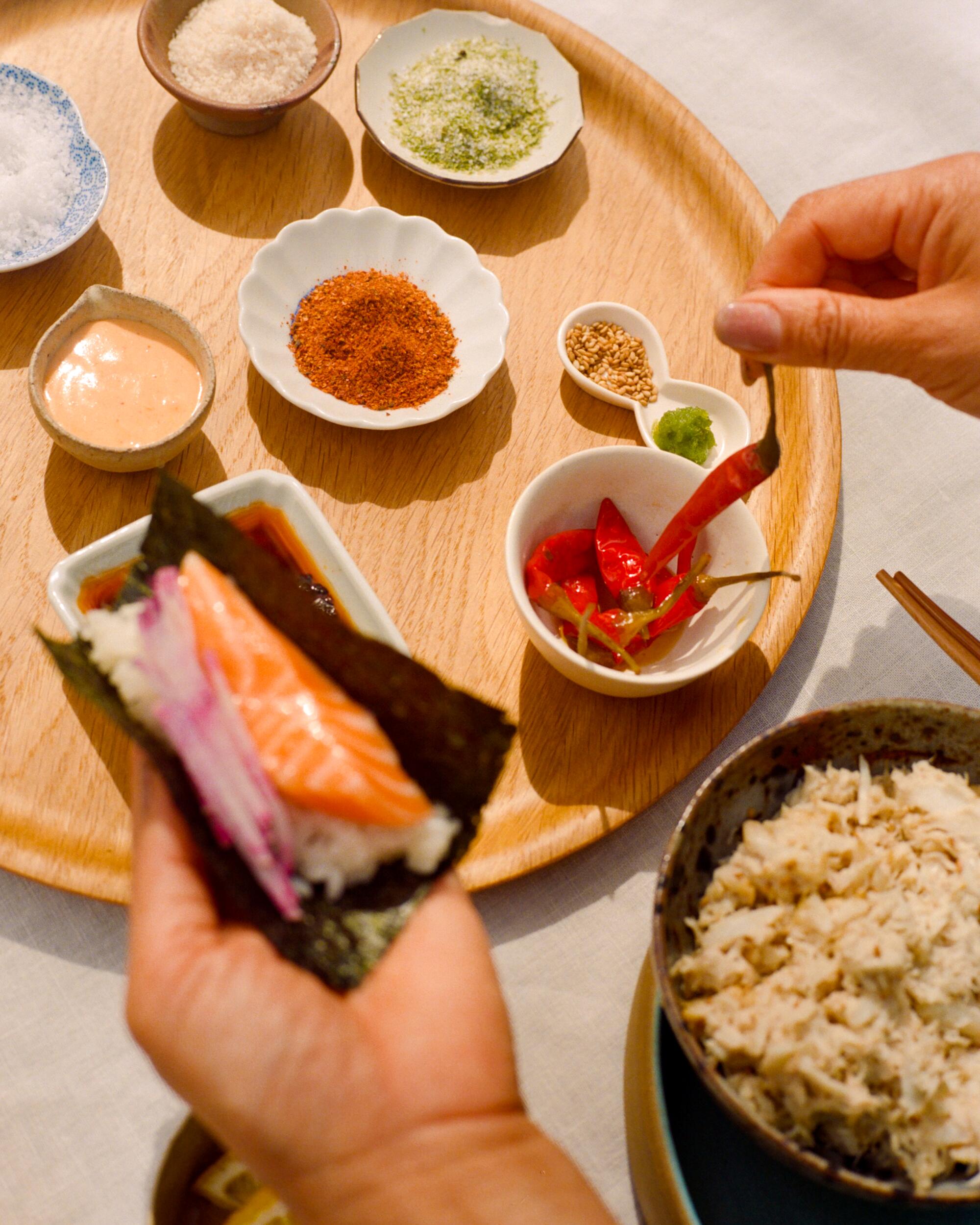
To fan, or not to fan? The traditional method for preparing sushi rice is to fan it while mixing in the vinegar seasoning. It’s said that fanning the rice to cool it down helps give it sheen and a “chewy” texture. My mom fans her rice; my grandma fanned her rice. But increasingly, friends and even sushi chefs tell me that for small amounts (3 to 5 cups of rice), it isn’t necessary, especially if it isn’t being served immediately. So, fanning optional.
An ode to the secretly best California roll, perfected over two decades at Yama Seafood in the San Gabriel Valley.
Fillings and condiments
One of the most inspiring hand roll restaurants in the world is Awomb in Kyoto. It’s known for the unique way it serves hand rolls, called teori (ori means weave) because the variety of ingredients weaves so many flavors together.
The hand roll combinations change seasonally but might include soy-simmered bitter melon with Japanese pear and parsley; ginger preserved with sake lees, pickled mackerel and chervil; pork pâté with fig and paprika; yuba (one of the tofu products Kyoto is famous for) with cherry tomato and kelp flakes; matcha omelet with grilled squid; grilled shiitake mushrooms with cheese; marinated bok choy with dragon fruit and thyme; and griddled seitan with grape and edible flowers. These might be served composed on the same platter, along with more combinations, small squares of nori and a bowl of rice.
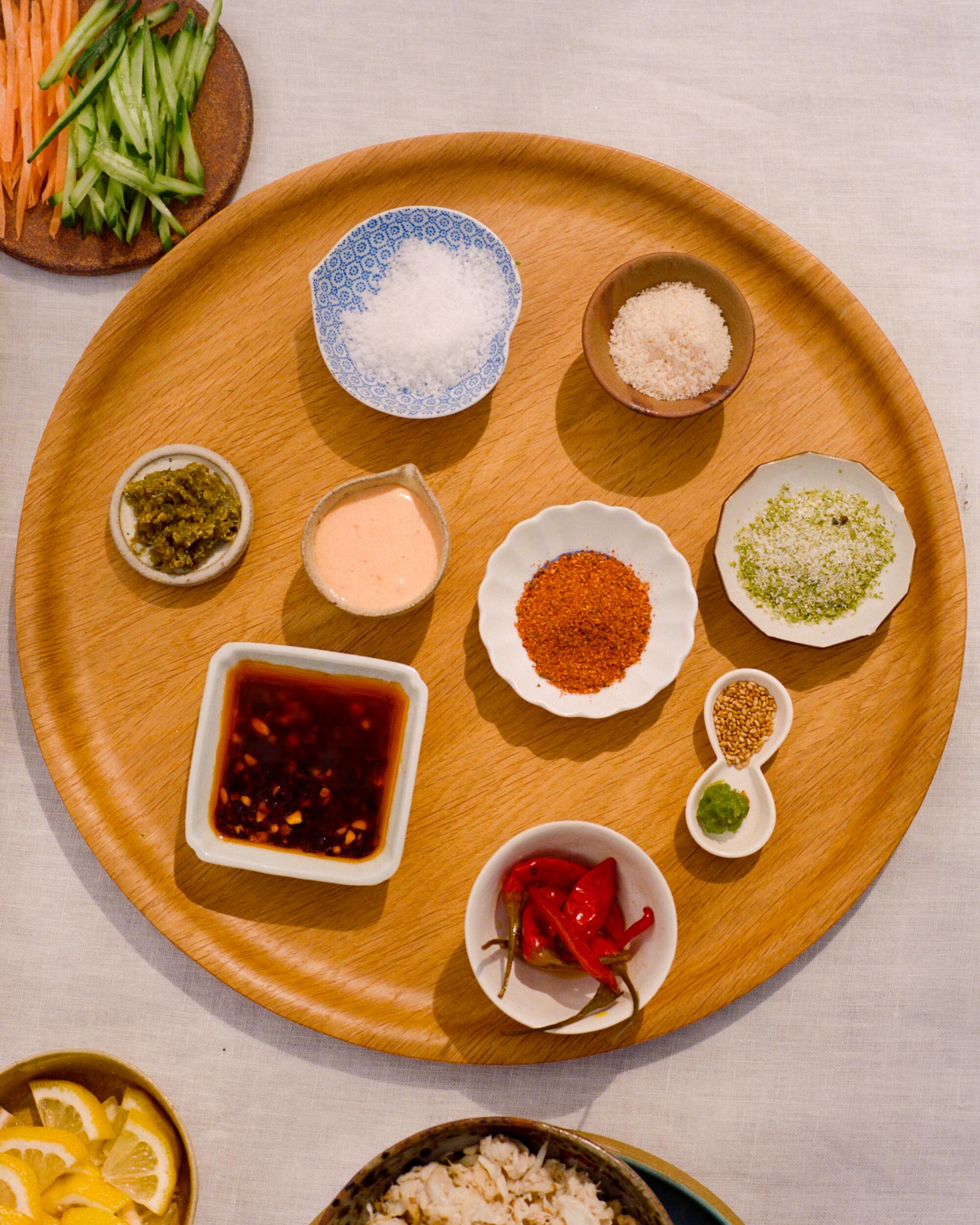
When it comes to fillings, Afuso is an aficionado. “There are no rules,” she says, “but curation makes it special.”
A family-style spread often will include sashimi. Sashimi-grade fish is available at many Japanese markets. Luxe Seafood, local fish supplier to Los Angeles sushi bars, isn’t open to the public, but the company provides sashimi such as hamachi (yellowtail) and salmon, as well as cooked tiny shrimp, to Nijiya and Tokyo Central markets. Downtown wholesale seafood market Los Angeles Fish Co. is open to the public. But raw fish isn’t necessary; smoked fish and tinned fish make for delicious hand rolls too.
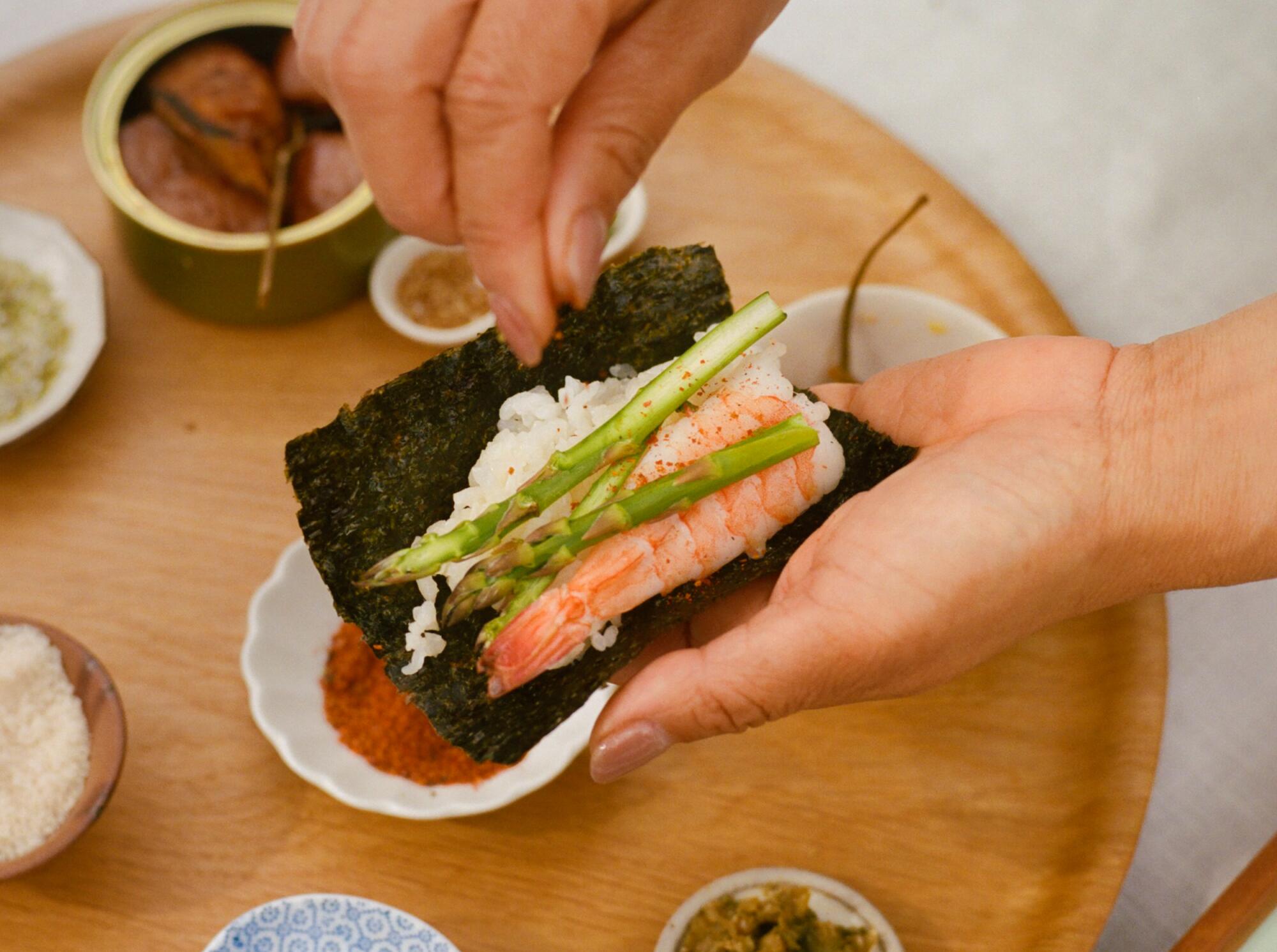
The owner of the Joint talks seafood, preservation and a sprawling new facility that will bring dry-aged fish to the masses.
Fresh vegetables are key. I love crunchy raw cucumbers, asparagus, okra, carrots, yamaimo (Japanese mountain yam), all kinds of radishes and radish sprouts. Sliced avocado. Anything pickled, especially chiles. The zing of fresh shiso (whole leaves or finely sliced) is the best.
And lots of condiments. It’s not just about the soy sauce and wasabi. Set out small bowls of Hawaiian pink salt, flaky sea salt, sesame seeds, nuts, salsa macha or chili crisp, yuzu kosho (Japanese fermented citrus and chile paste), shichimi togarashi spice blend, everything bagel seasoning, grated fresh ginger, pickled plum (umeboshi) paste or citrus zest. Use at will.
A few more favorite recent combinations:
- cucumber + shiso + asparagus + shichimi togarashi
- blue crab salad + salsa macha + sesame seeds
- smoked salmon + cream cheese + toasted pine nuts
- spicy tinned fish + thinly sliced celery + flat-leaf parsley
One of Afuso’s favorite combinations is potato salad topped with a tiny wedge of kishu mandarin, a la Awomb. She says spicy mayo on the table is a must. (Her recipe is: Mix ½ cup Kewpie mayo with 2 tablespoons sriracha, 1 tablespoon soy sauce and, if desired, the juice of half a lime.) So is cream cheese, for gravlax or cold-smoked trout with dill. “Lately I’ve been loving tinned smoked fish mixed with Kewpie and salsa macha. And red walnuts.”
Get the recipe:
How to make hand rolls for DIY sushi
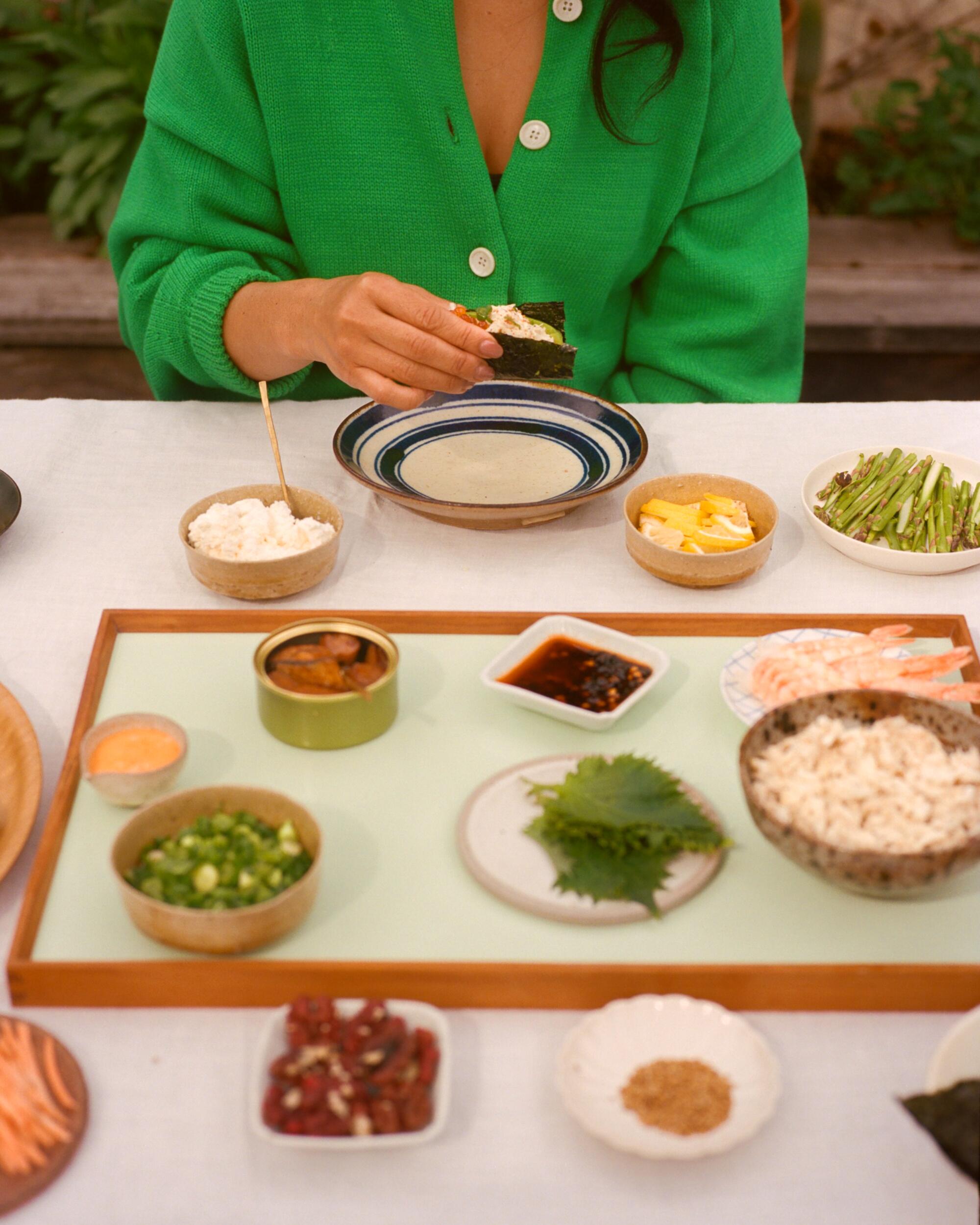
More to Read
Eat your way across L.A.
Get our weekly Tasting Notes newsletter for reviews, news and more.
You may occasionally receive promotional content from the Los Angeles Times.




